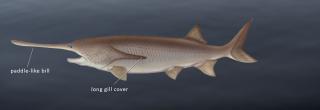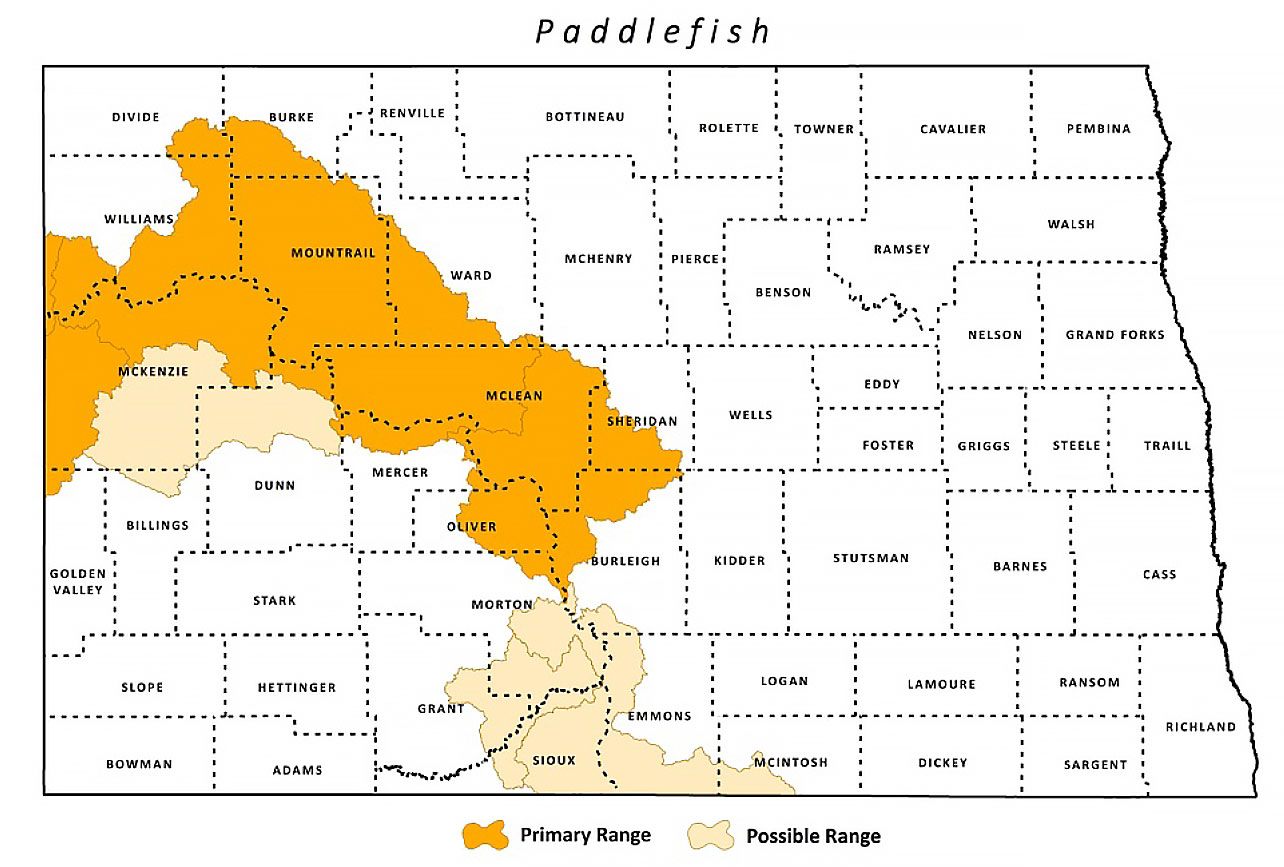
Paddlefish
| Scientific Name | Polyodon spathula |
|---|---|
| General Description | Can grow 7 feet in length and can weigh over 100 pounds. Large paddle-shaped snout. Smooth skin has no scales. Color ranges from blue-gray to nearly black with a lighter underside. Long fleshy gill covers. |
| Status | Year-round resident. |
| Abundance | Locally common. |
| Primary Habitat | Large river species. |
| Federal Status | None. |
| Reason for Designation | Loss of river habitat due to channelization and impoundment has caused declines in this species within the state and range wide. |
Locations and Conditions of Key Habitat
Preferred Habitat
In summer months, slack water areas of a river are a preferred habitat for Paddlefish. If this is not available, areas of low flow are sought such as behind sandbars, wing dams, or other structures. In winter Paddlefish move into the deeper water of Lake Sakakawea. Paddlefish spawn in the spring and lay their eggs over silt-free gravel beds.
Key Areas and Conditions for Paddlefish in North Dakota
The two most important areas for Paddlefish in North Dakota are the Missouri River from upper Lake Sakakawea to the Montana border, and the Yellowstone River. These two river stretches are used by the Paddlefish as migration routes to their spawning areas.
Problems Which May Affect this Species
Habitat
Impoundments along the Missouri River System have changed the flow regime of the river and cover needed for spawning habitat. Slower flows have allowed silt to cover important gravel beds, making them unusable by spawning fish. As a result, reproduction only occurs in the wild when conditions are favorable in the Yellowstone River. Dams have also impeded the movement of fish throughout the system, separating populations. This brings up concerns about genetic integrity.
Other Natural or Manmade Factors
Over-harvest for the fishes’ valuable roe is a concern for this species. The North Dakota Game and Fish Department regulates a controlled harvest for Paddlefish as a sport fish. Water withdrawal or diversion for irrigation from the Yellowstone River is a growing concern.
Research and Survey Efforts
Current Research or Surveys
- Currently populations within the Missouri River system are being monitored by use of information obtained from harvested fish and tagging studies. Age, growth rates, and sexual structure of the population are being documented.
- Young-of-the-year surveys are conducted annually on the upper end of Lake Sakakawea.
Previous Research or Surveys
- The North Dakota Game and Fish Department surveyed stretches of the Missouri River below Garrison dam and Lake Oahe to document populations.
- A Habitat Suitability Index (HSI) was developed for the Paddlefish by the US Fish and Wildlife Service in 1984 and again in 1987.
- A study of the predation of Walleye and Sauger on young Paddlefish was conducted in 1994 and 2002.
- The use of visual observations for estimating relative abundance was tested in 1997.
Additional Research or Surveys Needed
- No additional research and survey efforts have been identified.
Management Recommendations
- Protect rivers, streams, and riparian areas where possible (i.e. easements and/or acquisition).
- Work with partners to ensure Swampbuster provisions are maintained.
- Continue to use the Section 404 program to ensure affected rivers and riparian areas are mitigated to replace form and function.
- Continue to work with other federal agencies (i.e. FAA and FHWA) not covered by Section 404 or Swampbuster to ensure affected rivers and riparian areas are mitigated to replace form and function.
- Continue to work with NDSWC to develop minimum in-stream flow recommendations.
- Develop and promote incentive programs to restore riparian areas.
- Continue to work with ND 319 Task Force in prioritizing projects within impaired watersheds and implementing BMP’s.
- Develop and promote incentive programs for adjacent landowners to improve bank stability through land use changes (e.g. RRBRP).
- Promote non-traditional bank stabilization measures (i.e. root wads, willow waddles, vegetative slope).
- Implement intake conditions or recommendations (i.e. screening and velocity requirements).
- Work with the dam owners for potential removal or modification.
- Cooperate with Fisheries Division on state aquatic nuisance species plan.
- Survey areas of data gaps. Conduct research/surveys to establish baseline information on SCP.
- Continue to work with partners in promoting and distributing educational materials related to river, stream and riparian values and good stewardship.
Monitoring Plans
Currently populations within the Missouri River system are being monitored by use of information obtained from harvested fish and tagging studies. Age, growth rates, and sexual structure of the population are being documented.
2005-2015 PROGRESS
The Paddlefish maintains its Level II Species of Conservation Priority. This species is highly regulated as a game fish by the North Dakota Game and Fish Department’s fisheries division.

Note: A listing of works consulted when compiling the information on this page may be found in the 2015 State Wildlife Action Plan.
